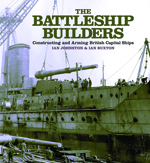
The Battleship Builders – Constructing and Arming British capital Ships
by Ian Johnston & Ian Buxton
Seaforth Publishing, Barnsley
www.seaforthpublishing.com
ISBN 978-1-84832-093-2
£30.00 in the UK
Reviewed by David Hobbs
THE BRITISH built more battleships than any other nation and this fascinating book contains a wealth of detail about the shipyards, dockyards, ordnance works, steel works, foundries and other sites where the hulls and their systems were built as well as the design and functioning of the ships themselves. There are maps of the various yards with explanatory notes about the processes that went on in their buildings; descriptions of how gun barrels, working chambers, turrets, boilers and turbines were assembled ashore and then dismantled to be taken to the ships for installation and a wealth of other detail, including the manpower in the factories.
Much of this might have been largely forgotten and lost were it not for this book which makes a unique contribution to the available published material about the battleship era. It is well illustrated with photographs of ships, weapons and machinery under construction and many other detailed elements including workshops and components. Tables give details of construction and cost; the battlecruiser HMAS Australia, for instance, is listed as costing £1,783,190 or £94.85 per ton. The ship’s four twin turrets, each containing two 12 inch Mark B.VIII* guns were constructed under contract 121G by Vickers at Barrow-in-Furness although the hull was built by John Brown & Co on Clydebank. Each turret cost £59,123 and their total cost was £236,494, yielding a substantial profit for Vickers.
In addition to the processes needed to build a battleship, the book describes the expansion of the industries prior to 1914, their dramatic decline after the Washington Naval Treaty, especially of those specialising in armour and gun manufacture and the inability of the run-down industry to cope with all the orders when re-armament began in the late 1930s. All of this is presented in a readable style that makes this book difficult to put down. Appendices give further information including an account of the industry created to scrap battleships at the end of their operational lives.
I found information that was both new to me and interesting on nearly every page and this must be considered the definitive book on the design and construction of these iconic vessels and the industries that created them. It also has a great deal to say about the relationship between British industry and the Royal Navy in the years between the late nineteenth and mid twentieth centuries. The authors must be congratulated for locating the surviving archives together with the fascinating collection of images. Battleship Builders is one of the best naval titles I have seen and I am delighted to have added it to my collection. I understand that it is selling rapidly in both the UK and the USA. I wholeheartedly recommend it and suggest you obtain a copy before stocks of the first edition run out.



